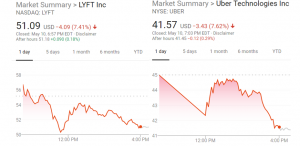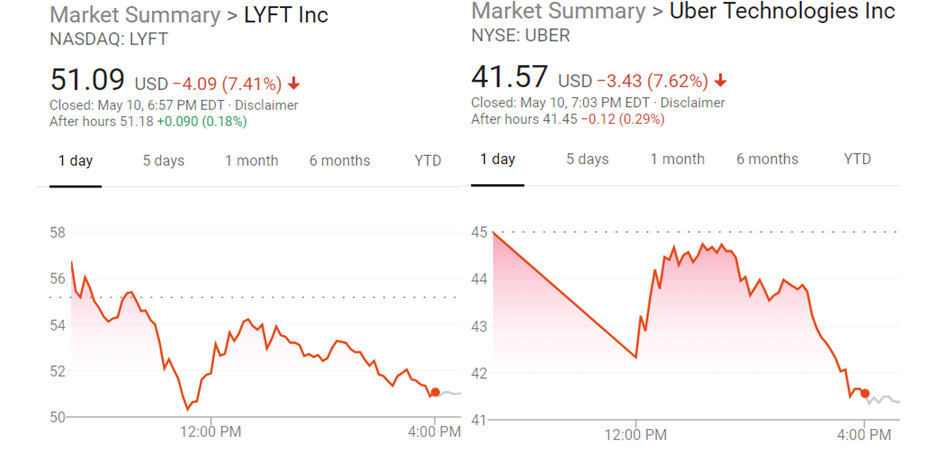 Uber and Lyft blew it with their initial public offerings over the past couple weeks. Both companies opted to cash out founders and early investors while tossing pennies to long-supportive drivers in the form of bonuses. The short-term cash out focus could sound the death knell of these market leaders.
Uber and Lyft blew it with their initial public offerings over the past couple weeks. Both companies opted to cash out founders and early investors while tossing pennies to long-supportive drivers in the form of bonuses. The short-term cash out focus could sound the death knell of these market leaders.
Both companies extracted billions from investors in the process – but both companies also failed to attract the kind of money necessary to rebuild their business models and establish a path to long-term profitability. The one core fundamental issue they neglected: driver compensation and churn.
The U.S. is the home market for both companies and the employment environment in the U.S. is becoming increasingly hostile to ride hailing. Not only are local municipalities, like New York, forcing transportation network companies (TNCs) like Uber and Lyft to treat their drivers as employees – the available pool of drivers is shrinking along with the unemployment rate.
Strategy Analytics estimates that both Uber and Lyft will have to continue to recruit drivers globally and locally. At the same time, both companies are likely to be reducing driver compensation to address their debt and cash-flow challenges. All of these vectors point to ongoing driver recruitment and compensation challenges – especially in a market where competing services – including Amazon’s delivery operations – promise more reliable compensation with benefits.
What Uber and Lyft failed to recognize was the need to treat drivers, and maybe even passengers, as owners in the companies. Both drivers and passengers have been suspending their disbelief for the past five-plus years to make the service viable if not profitable.
Both Uber and Lyft seemed to recognize the importance of their drivers, but both companies missed the opportunity to set up a stock option plan of some sort to convert existing, and eventually new, drivers into vested owners of the company. What has always been missing from the Uber/Lyft experience has been a recognition or feeling among drivers that they were actually “owners,” representatives of the company and the brand.
The lack of this feeling is manifest in the fact that most, though not all, drivers – that I have met – drive for both. The driving for both proposition feeds the overall gaming the system mentality of the Uber/Lyft experience – also manifest in rides periodically cancelled by drivers that may not want to drive to your preferred destination.
Uber and Lyft (and Yandex and Ola and DiDi etc.) have overcome the supply and demand challenges of getting rides to drivers on the fly in a reasonable reliable manner. But they have failed to create any loyalty among drivers or passengers – leaving the door open to any new entrant seeking to offer a superior experience.
One such player, Bounce, is offering an ownership experience for drivers and passengers – though the company is only active in a handful of markets. The struggle of starting up in a market saturated and dominated by huge competitors – in this case Lyft and Uber – is clear and daunting and is captured in this review by Will Preston for TheRideShareGuy:
https://therideshareguy.com/what-is-it-like-to-drive-for-bounce/
The most important takeaway from this review, for me, is the inclination of Uber and Lyft drivers and passengers, both, to complain about the experience. Bounce seeks to address the flaws in the system by creating a share vesting program for both drivers and passengers built around recruitment referrals for both. Bounce also seeks to leverage relationships with event operators to provide queue-based post-event transportation.
The Bounce model and strategy are detailed here: https://therideshareguy.com/bounce-rideshare/
The long-term prospects for Bounce are unclear to me. The long-term prospects for Uber and Lyft are even less clear in view of their decision not to enter into any longer-term relationship with their drivers – even though some of those drivers have entered into long-term multi-year relationships with Uber and Lyft.
By using the IPOs to reward investors and founders and shun drivers, Uber and Lyft have signed their own death warrants. The IPOs have all the earmarks of an exit strategy not a survival plan. I may continue to use the services where and when they are convenient, but the IPOs have left a sour smell in my nose and a bad taste in my mouth. It’s telling that drivers did not celebrate the IPOs – if they even knew they were taking place – they went on strike.
These IPOs were not clever or game changing. They were nothing less than craven and mark the beginning of the end of ride hailing. It is only a matter of time. The current business model will not stand.
Share this post via:






Flynn Was Right: How a 2003 Warning Foretold Today’s Architectural Pivot